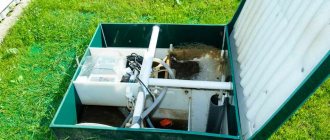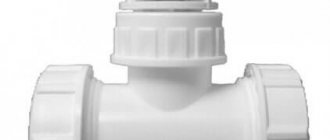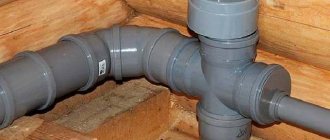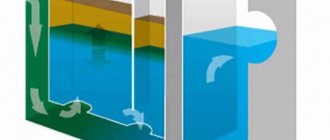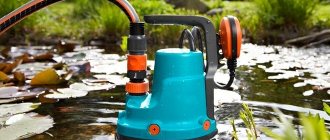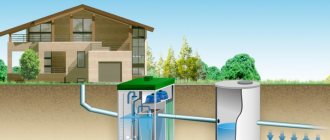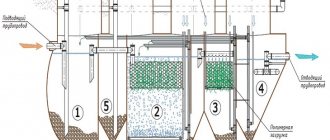The construction of an autonomous sewer system at a summer cottage begins with the selection of a system suitable for the price and quality of wastewater treatment.
The optimal solution is to tie into the centralized sewerage mainline, but suburban areas in the Leningrad region are for the most part deprived of this opportunity. Therefore, the only possible way to organize the processing and disposal of wastewater remains the arrangement of a private septic tank.
You just need to understand the principles of operation of different types of autonomous sewage systems and choose the appropriate option, taking into account the characteristics of the site, preferences and needs.
All existing types are divided into three groups:
- drainage pits made of different materials;
- septic tanks;
- local treatment plants.
Autonomous sewerage: how the drainage pit works
The most primitive way to dispose of wastewater is a drainage pit. The principle of operation is simple: liquid masses are transported from the house through the drain pipe into the tank. If the container is sealed, household waste accumulates until it is filled, after which it is pumped out using sewer equipment. The procedure is repeated every 2–4 weeks. The frequency of pumping depends on the intensity of sewer use.
There is a type of cesspool in the form of a filtration tank. Concrete rings or a tank without a bottom are installed in the pit, and the lower part is covered with crushed stone and sand. Such autonomous sewerage devices are permitted by law only to serve the minimum number of points of water use in the house - showers and toilets. It is prohibited to install cesspools in the city, near neighboring buildings and water intake sources (wells and boreholes).
Disadvantages of a drain pit:
- Persistent unpleasant odor.
- Cluster of insects
- Costs for regular pumping of wastewater.
Construction of an autonomous drainage system
Storage well installation diagram
As a rule, they begin to build a sewer system in suburban housing after the main stages of construction work. That is, when both the walls and roof of the main building are almost completely erected.
Stages of construction work on the arrangement of sewerage elements outside:
- The first to dig is a trench leading from the liquid collectors to the sump itself. Arranging the bottom of the trench at a certain slope (per meter of length - 2-2.4 cm) will help ensure spontaneous flow of wastewater in the pipeline.
- The bottom of the prepared trench is lined with a sand cushion along its entire length (to the very point of connection with the sump storage tank).
- Next, proceed to the direct installation of pipes entering the drainage main. The junction of the final pipe is thoroughly sealed, thoroughly treated with an airtight compound.
- Then they move on to the structure of the filtering field, combining all the elements together.
Professional installation tips:
- During the laying process, it is better to place polypropylene pipes in specially designed concrete boxes, which will ensure their reliable protection from various influences. PVC pipes can be laid directly in the soil without placing them in a protective casing (of any type).
- The depth of laying sewer pipes is selected according to the requirements for placing sewage communications slightly above the freezing mark of the soil in a given area. This parameter is not standardized for each individual situation, but is calculated individually for a specific climatic region. For the middle zone, according to geophysical research, this mark is equivalent to 1.3 meters of depth.
- During frosty winters in this area, it is also necessary to insulate the pipeline with the most affordable type of any heat-insulating material.
How does an autonomous sewage system work in the form of a septic tank?
For country houses inhabited by 3–4 people, an autonomous sewage system such as a septic tank is suitable. The design is a factory-made container of several chambers. The wastewater coming from the house undergoes at least double purification:
- Mechanical. Inside the chamber, the waste settles and separates, after which the insoluble solid substance settles to the bottom, and the liquid moves to the next compartment.
- Biological. Filtration takes about three days. Organic compounds are processed by anaerobic bacteria in a crust on the surface of the liquid. Microorganisms do not require oxygen. During cleaning, methane is released, so the septic tank is equipped with ventilation.
Multi-chamber septic tanks are becoming the best choice for seasonal homes, for areas without an electrical connection or with intermittent power supply. The non-volatile system requires only regular filter cleaning (every 1-2 months).
Pros and cons of septic tanks
The simplest and most cost-effective solution is to install a sealed cesspool, which has the following advantages:
- simplicity;
- minor labor costs for installation;
- low price.
The disadvantages of a cesspool include small drainage capacity, bad smell and monthly pumping of contents. A standard cesspool without a bottom is prohibited, as it pollutes the environment. An exception is the construction of a pit without a bottom, with a wastewater volume of no more than 1 cubic meter per day.
A septic tank, presented in the form of a well, in which mechanical wastewater treatment occurs with bacteria, has the following advantages:
- low price for installation;
- the environment is not polluted during the operation of the system;
- autonomous work.
The disadvantages of the device include an average degree of cleaning, operating costs and the need to install additional equipment. To install a sewer system, a self-installation can be used, the principle of which is similar to a septic tank. This design has the following advantages:
- long service life;
- high degree of purification;
- no unpleasant odor;
- Calling the sewers once a year.
One of the disadvantages of the system is its high cost. The Tank system is presented in the form of a cubic container with a ribbed surface. The wall thickness is 15 mm. This durable design is made from polypropylene. Energy independence and rare pumping of sediment are the main advantages of the device.
Biorefinery stations have a low percentage of purification, so they are equipped with a post-treatment system. For this purpose, filtering fields are set up. If the soil does not allow this, a ready-made system is installed.
Autonomous sewage system
To appreciate the benefits of local treatment plants, you should learn more about how autonomous sewers of this type work. The system provides maximum wastewater treatment (up to 98%).
Volatile septic tanks are complex cleaning systems with compressors (Biodeka, Volgar, Unilos-Astra, Topas, Kolo Vesi, etc.). These factory-assembled complexes are equipped with equipment for multi-stage automatic filtration.
Principle of operation:
- Primary cleaning mechanically. The receiving compartment is equipped with mechanical filters that capture fats and large contaminants.
- Aerobic treatment (biofiltration). Aerobic bacteria process wastewater, breaking it down into sludge and water.
- Anaerobic filtration. Organic compounds are removed in a compartment with anaerobic microorganisms that do not require oxygen.
- Final cleaning, providing mechanical filtration.
VOCs do not require maintenance. About once a month, the site owner inspects the internal cameras. Mechanical filters are cleaned every 6 months, parts are replaced and serviced every few years (depending on the nature of use).
The principle of operation of an autonomous sewage system in a private house: selection parameters
In order not to make a mistake when choosing an autonomous sewerage device, you need to consider the following parameters:
- average daily volume of wastewater (predicted system load);
- quality of power supply at the site;
- terrain features, groundwater level, the presence of nearby natural reservoirs and drinking wells.
Factory septic tanks are made of polymers or metal. Sealed plastic containers are made using a seamless method and are not susceptible to corrosion or exposure to chemicals. Metal tanks are less reliable because they have welded seams, are susceptible to corrosion and cool quickly.
Factory septic tanks
You can find many different designs of ready-made septic tanks on the market. The principle of their operation remains the same as that of homemade devices.
Factory septic tanks have several interesting advantages:
- ease of installation: the most difficult work will be preparing the pit for installation;
- reliability and long service life;
- the ability to choose the most suitable model. There are designs with different performance and volume. You can always choose a small structure for a summer cottage, or you can choose a serious device that can serve a small hotel;
- The factory septic tank is initially completely sealed, so it can be installed anywhere, regardless of the groundwater level.
The disadvantages of such devices are:
- quite high price;
- the need for additional treatment, since the septic tank itself can clean up to 70% of wastewater.
Autonomous sewerage: how VOCs work in a country house
Considering the range of local autonomous sewers, how this or that system works should be clarified with specialists before planning installation on the site. VOC is a complex system of several interconnected sealed chambers.
The first chamber is a settling tank. Here the wastewater is separated mechanically. The volume of the receiving chamber depends on the type of system and the required residence time of the waste in the receiving compartment. During the mechanical cleaning process, insoluble sediment sinks to the bottom, and water passes through a removable mesh filter basket. Large waste that ends up in the sewer system (vegetable peelings and other food debris) accumulates here.
In the second compartment, the liquid that has undergone primary purification undergoes biofiltration (the main stage of wastewater treatment). Depending on the model, this may be a chamber with an aerobic and anaerobic cleaning system or with combined processing. After this compartment, the wastewater is 80% purified. Next, the liquid enters the settling tank, where activated sludge is separated from process water. Water is removed from the installation, and the active one is stabilized in a special chamber.
deserves special attention . This is what distinguishes VOC from standard septic tanks. Most local stations are equipped with aeration tanks. This is the name for chambers with compressors that pump oxygen. The output is wastewater purified to 98%. Installation of such VOCs is possible in urban and suburban areas. There will be no problems obtaining permits.
Aerobic bacteria in the biofilter, which process waste, live inside the effluent. The colony population is regulated naturally. If the volume of wastewater has increased or it is necessary to speed up the cleaning, you only need to increase the volume of oxygen entering the chamber. The process is programmed, which reduces the hassle of the site owner to a minimum. Aerobic bacteria are not sensitive to the presence of chemicals in wastewater, so VOCs can be installed not only in residential buildings, but also in commercial facilities where detergents are intensively used.
The principle of operation of septic tanks
Autonomous sewerage consists of a local independent system equipped with pipes and an individual treatment facility. Elements of the device in question:
- external and internal pipeline;
- septic tank;
- compress (additional element).
The first chamber of the system is designed to separate wastewater. The volume of the tank varies and depends on the type of structure. Waste accumulates in the filter mesh. Additionally, the system is equipped with a chopper.
The three-chamber device is equipped with a container with biofilters, where all waste is processed. Factory systems are equipped with anaerobic and aerobic cleaning chambers.
At the outlet of the biofiltration tank, the purity of the effluent exceeds 80%. The masses can be discharged into a tunnel or onto a filtration field. Some systems provide a tank for final purification. The design, which operates on the principle of an active septic tank, is used when it is not connected to electricity.
This system has 1-2 cameras and works without interruption. In this case, it takes 3 days to process the wastewater. Organic matter is processed by bacteria inhabited in the septic tank. During processing, heat and gases are released. The number of microorganisms depends on the chemical composition of the masses and the frequency of sewage use. High-quality cleaning will be carried out for 3 months from the moment the sewer system is launched.
The aerobic station is designed according to the following principle: bacteria live inside the tank. Their quantity can be regulated naturally. If you need to increase the volume of wastewater or speed up the treatment, then their quantity is increased. During operation, oxygen is supplied automatically. Anaerobic microorganisms are weakly sensitive to chemicals present in wastewater. Therefore, such stations are installed without restrictions.
The main differences between different types of autonomous sewers
Regardless of the operating principle of an autonomous sewer system, all its types accumulate household wastewater. The differences lie in what happens to the waste later. Each system has advantages and disadvantages. Some are attracted by price, others by environmental friendliness, and still others by the lack of need for constant maintenance.
Cesspools are the simplest and most cost-effective option, but due to a number of disadvantages they are practically not used in modern homes. The principle of operation is simple: wastewater from the house flows by gravity into a reservoir dug into the ground. The sealed container is regularly cleaned by vacuum trucks using special equipment. An improved option is a filtration pit, which instead of a bottom has a kind of filter made of crushed stone with sand. The wastewater is absorbed into the ground, partially purified by such a filter. The disadvantage of a pit is the constant unpleasant odor and the cost of pumping.
Septic tanks are structures made from a single container, divided into chambers that provide consistent wastewater treatment. In the receiving compartment, the mass is divided into heavy sediment, which sinks to the bottom, and liquid, which flows into the second tank. Here, anaerobic bacteria process organic matter, producing water purified to a certain quality.
Local treatment stations are more expensive, but are the most productive and modern solution.
The wastewater goes through several stages of purification, and at the end the purity of the drain reaches 98%. The station is volatile and requires a reliable source of electricity. Automated operation of VOCs does not require human intervention. Only routine inspection is required, as well as maintenance approximately once a year.
cesspool
The simplest type of autonomous sewage system in a private house can be called a cesspool. This design is made in the form of a tank made of brick, reinforced concrete or plastic, which is equipped with a hatch in the upper part. For the tank, they dig a hole about 3 meters deep, and the groundwater level should be taken into account.
The main condition that must be observed when arranging a cesspool is the absolute tightness of the tank.
For this reason, you need to understand what an autonomous sewage system means and follow several rules:
- When using bricks, preference is given to ceramic products. The reservoir should have a round shape.
- Reinforced concrete rings are characterized by high strength, however, due to their massiveness, the services of a construction crane should be used for installation.
- For the construction of monolithic reinforced concrete structures, it is important to use high-quality reinforcement and a high-grade cement-sand mixture. It is also recommended to build formwork.
- When choosing a plastic tank, you should pay attention to the resistance of the material to the aggressive effects of various environments.
The principle of operation of the autonomous sewer system of a private house is the following scheme: a pipe with a diameter of at least 10 cm is removed from the sewer system inside the house. The pipe should be located with a slight slope towards the tank. The level depends on the depth of soil freezing; it is important that the pipe is below this mark.
To pump out accumulated sewage, a sewage disposal truck is periodically called, the frequency of calls depends on the rate of filling of the tank.
It is very important to prevent contamination of the soil with sewage, so you need to ensure that a distance of less than 35 cm is maintained between the liquid level and the soil. After each pumping, the tank must be disinfected.
A cesspool is characterized by the following advantages:
- Thanks to the complete sealing of the tank, contamination of the soil and groundwater is eliminated.
- You can do the construction yourself.
- Low cost of the system.
- The design is simple and at the same time highly effective.
- Complete energy independence; electricity is not required to operate the cesspool.
- Emptying the tank is quite simple using special equipment.
Despite the large number of advantages, it is also worth knowing about the disadvantages of such an autonomous sewage system:
- Cleaning the tank is rarely done but is quite expensive.
- In some cases, there may be an unpleasant odor near the cesspool.
- If the groundwater level is high, it is impossible to install such a sewer system. Sewage systems at high groundwater levels are arranged in a special way.
A cesspool can be called an effective type of autonomous sewage system for a private house, which is operated in the summer.
What does a modern sewer system of a private house consist of?
When choosing one of the modern treatment systems, you need to learn more about the design of an autonomous sewer system: how it works, how much space is needed for installation, what maintenance costs will be required, etc. The main elements of any system:
- A reservoir for storing wastewater (a cesspool, several septic tanks or a VOC tank) in relative proximity to the house.
- Internal communications (pipes laid in the house).
- External communications (a network of pipes laid with a slope underground to move wastewater into the sewer system).
- A filtration field (a bed of crushed stone with sand for post-treatment of wastewater), requiring regular maintenance.
Effluent from the house can move into the sewer system naturally (the pipe is laid with an inclination towards the septic tank).
To drain purified water, both forced and gravity options are used. The forced method is necessary for those users whose wastewater will be discharged onto the terrain, and gravity systems are suitable for those areas where a deep ditch has been dug, deeper than 80 cm, or there are well-draining soils (sand, sandy loam). In the latter case, a drainage well is installed.
Methods and stages of wastewater processing
For a clearer understanding of how autonomous sewers work, there are two ways to process wastewater:
- anaerobic;
- aerobic.
Anaerobic treatment occurs due to bacteria that decompose wastewater into water and methane. Heavy waste settles to the bottom. In this case, processing is carried out as follows:
- Contaminated particles are separated by weight. The heavy ones precipitate, the light ones remain on the surface of the wastewater.
- Particles that settle to the bottom are processed by anaerobic bacteria. The heat generated allows the septic tank to be used all year round without the risk of freezing.
- Wastewater is filtered through a bed of sand and crushed stone and further purified by soil aerobic bacteria.
Aerobic cleaning is used in more modern systems. Thanks to the use of aerobic filters, there is no need to create a drainage layer. Stations that provide complete treatment allow you to reuse treated wastewater for household needs. A high level of purification is achieved through the use of both aerobic and anaerobic microorganisms in one system. Cleansing occurs in several stages:
- The wastewater settles in the receiving chamber, where mechanical filters filter out large contaminants.
- Large particles are processed by anaerobic bacteria, as in septic tanks.
- The environment is saturated with oxygen necessary for the life support of aerobic bacteria. The latter quickly and productively process organic matter.
- Repeated settling occurs with sludge settling to the bottom and clean process water moving out.
A small amount of sludge accumulates in the off-grid system, so excess must be removed over time.
Main elements and parts, operating principle
The sewage system of a private house operates completely autonomously and in most cases is energy independent. Conventionally, it can be divided into 3 parts:
- Internal (house). Designed to collect wastewater from all plumbing fixtures and drain it into the outlet riser.
- Outdoor. Serves to drain wastewater into a storage tank.
- Treatment facilities. Designed for collection, purification and disposal of household waste.
If the distance from the house to the septic tank is more than 10 m, then an intermediate well with an inspection insert is installed.
Cesspools, multi-section septic tanks with filtration of purified water, or deep treatment stations can be used to collect household wastewater.
In the latter, the degree of purification is so high that it allows the use of filtered water for irrigation.
The operating principle of treatment facilities is as follows:
Scheme of operation of treatment facilities.
- Once in the storage tank, solid waste fractions precipitate, and clarified water flows through the overflow pipe into the sump.
- The liquid settles in it. Suspensions in the form of silt sink to the bottom. Having reached the overflow level, the liquid enters the filtration well, from which it drains into the ground through a crushed stone-sand filter.
In the sediment formed at the bottom of the chambers, under the influence of anaerobic bacteria, fermentation and decay processes occur with the release of methane. The product of processing is sludge, which is removed from the tank as it accumulates.
The quality of cleaning depends on the volume of the cleaning device and the intensity of its filling.
Methods for regular drain cleaning
Having figured out how an autonomous sewage system works, you have to decide on the frequency and nature of maintenance of the selected system. The silt that accumulates at the bottom of the tanks and in the pipes transforms over time into a kind of clay and requires removal using special tools. To prevent the situation from getting worse, it is necessary to perform system maintenance in a timely manner.
- Manual cleaning involves emptying the tank using a drainage and fecal pump. The wastewater is pumped into another container, which is removed. Sludge deposits are removed from the bottom with a shovel, and the walls are washed under water pressure. Dirty water is pumped out into a mobile container.
- The sewer service uses a machine with a vacuum pump and a washing system to empty and clean the container.
- In complete treatment stations, sludge accumulations are removed in an aerobic stabilizer. The sludge is pumped to a compost heap, from where it can then be used as fertilizer. The container is cleaned with water pressure, the dirty liquid is pumped out of it and filled with clean water.
What you need to know about autonomous treatment plants: advantages and installation
Modern VOCs have a number of advantages. Before making a choice, it is worth learning more about what such an autonomous sewage system is: how it works, how it is installed and what advantages it has. Let's list the main ones:
- The design and operating principle of the system maintain environmental cleanliness on the site. No odors or environmental pollution.
- A minimum of maintenance is required, and the system itself will last more than 50 years.
- Autonomous systems are installed on any type of soil, regardless of the groundwater level.
- An important parameter to consider when choosing is the number of sewer users.
Our company’s specialists will help you choose the best option for autonomous sewerage:
- evaluate the characteristics of the site and soil;
- calculate the volume of the septic tank taking into account the number of residents in the house;
- will offer a cleaning system at an affordable price.
Call for more information.
Properties of modern systems
In order for an autonomous sewage system for a private home to be effective, it must meet the following criteria:
- The wastewater treatment rate is within 95-97%.
- Compactness. The areas for building private houses are limited, let alone a summer house, so such a system should take up little space.
- Eco-friendly cleaning process.
- Easy to operate and maintain.
- Resistance to environmental influences.
- Quiet operation, no odors, optimal operation without electricity.
- Easy to install and low cost to operate.
- Simple design, which does not affect the quality of wastewater treatment.
Note! A modern autonomous sewage system for a cottage can have different principles of wastewater treatment: mechanical, biological, chemical.

